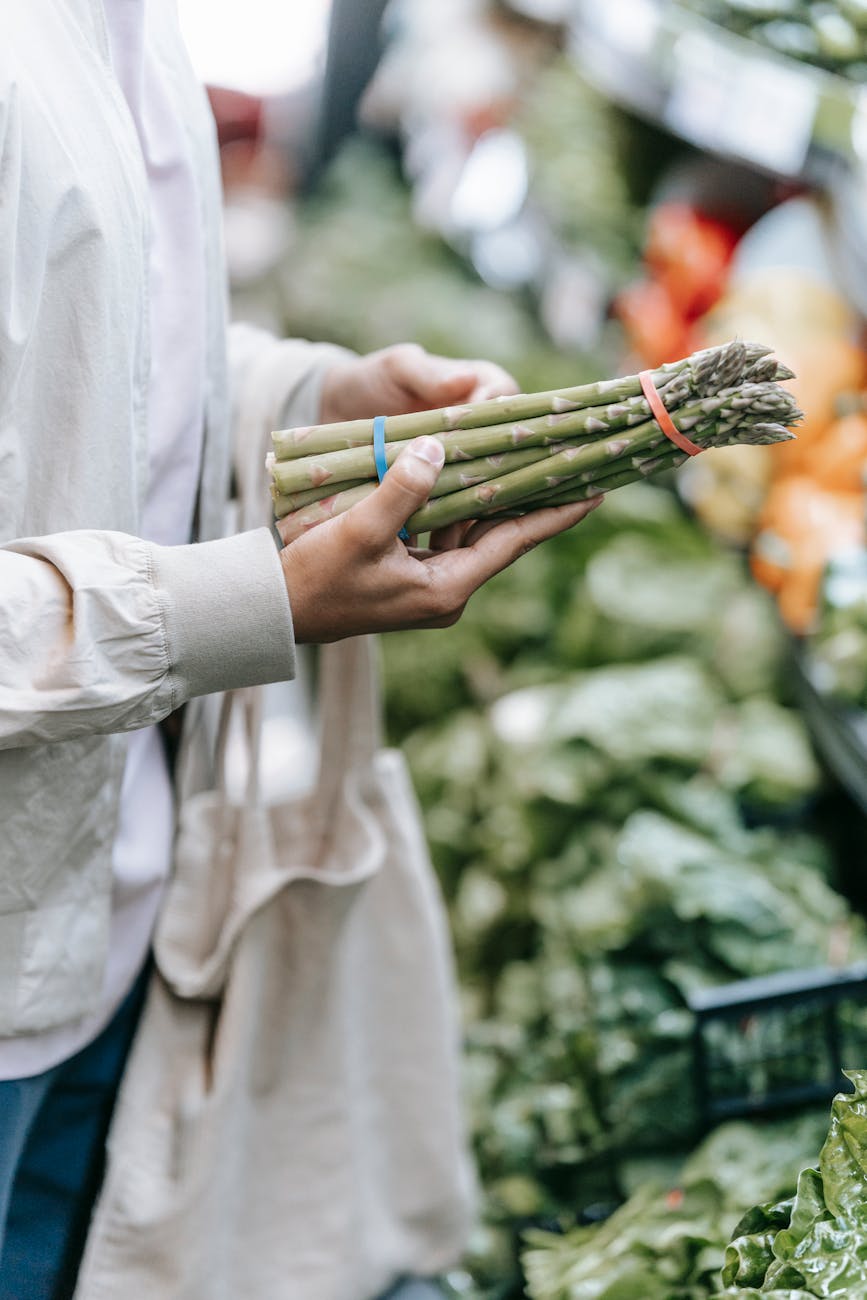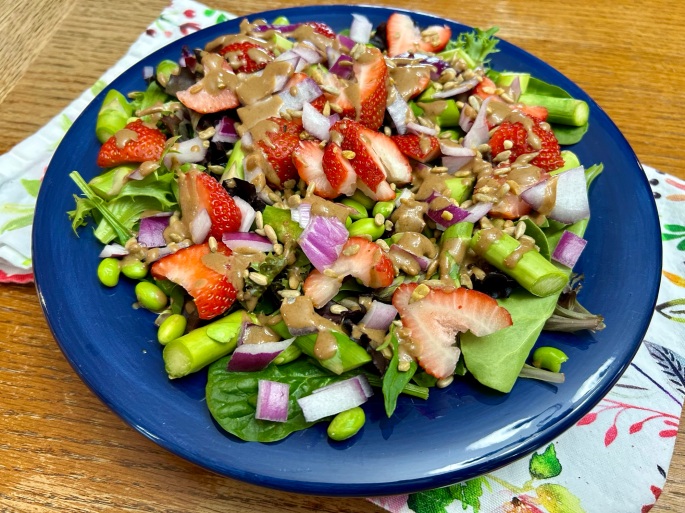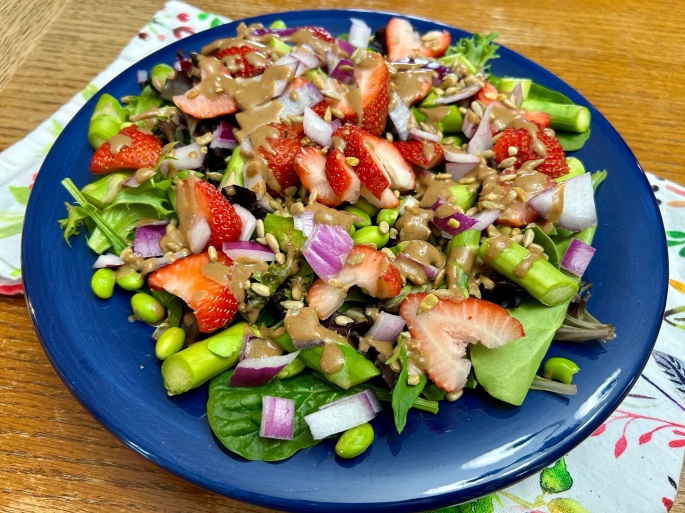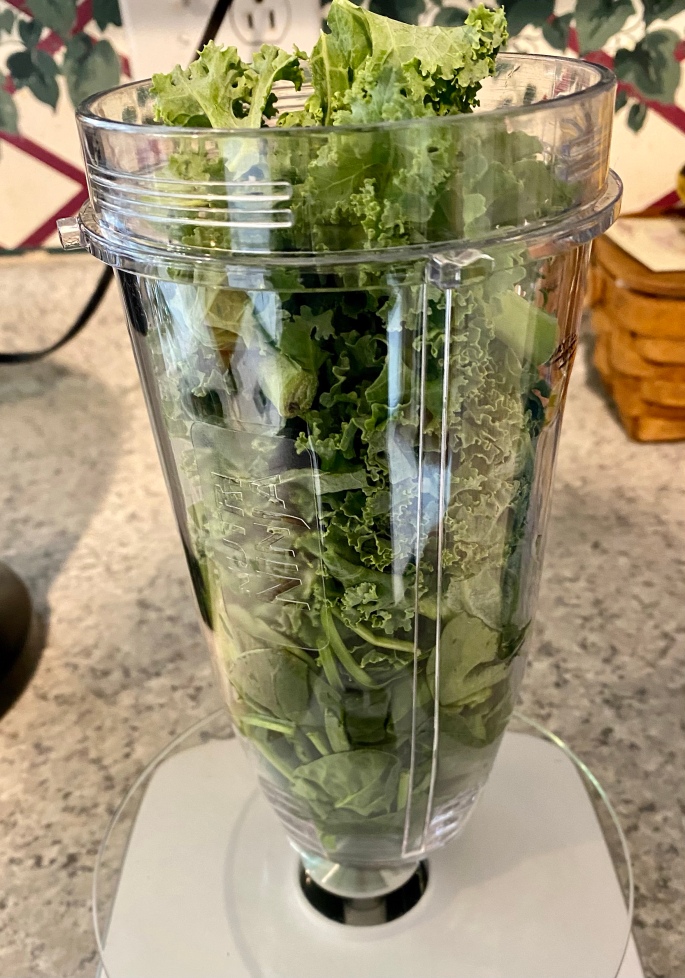Featuring asparagus, strawberries, spring mix, and spinach
“Mother Nature’s powers cannot be stuffed into a pill.”–Dr. Micheal Gregor

pill popping 💊
My husband, John, and I can’t help but giggle every time we see commercials touting the benefits of taking a certain brand of daily vitamins. This company claims their product provides vitamins and minerals found in fruits and vegetables that we, the lowly consumer, don’t have time to eat. It especially targets those of us who are older, espousing that by taking these pills, as many as six per day, we will infuse our frail, feeble frames with the vigor and vitality of our former, younger self.
While there is nothing inherently wrong with taking a multivitamin and/or other key supplements, they should never replace our need for daily consumption of fruits and vegetables. According to multiple sources, such as, The Better Health Channel, National Institutes of Health, and Harvard’s T.H. Chan School of Public Health, regularly consuming fruits and vegetables provides the body with important vitamins, minerals, plant chemicals, and a significant source of fiber. Furthermore, a diet rich in fruits and vegetables have been linked to “lowered blood pressure, reduced risk of heart disease and stroke, prevention of some types of cancers, lowered risk of eye and digestive problems, and have a positive effect on blood sugar . . . .” These are benefits that can’t be bottled into a pill.

Planted in Health 🌱
Of course, I am preaching to the choir, my dear readers. If you are reading this, you are keenly aware of the benefits fruits and veggies offer. And, yet, due to clever and slick marketing tactics, Americans have been spending billions in recent years on vitamins and other supplements according to Northwestern Now and Harvard Medical School. While there are those who do need a few key supplements due to specific health issues, such as those with Crohn’s disease, celiac disease, and ulcerative colitis to name a few, the average healthy adult can get all the vitamins and minerals they need through a well-balanced diet. Besides, there are numerous tasty and simple ways to incorporate fruit and veggies into your diet.

Spring produce 🥬
Spring is the perfect time to take advantage of the fruits and vegetables that come into season early, such as greens, asparagus, and strawberries. Many of these items are often available at local produce stands and markets. Plus, they can also be found, usually at discounted prices when in-season, at local grocery stores. Either way, from now until early June, is the perfect time to grab up these produce deals.

The salad recipe I am sharing with you is one delicious way to incorporate a variety of spring vegetables and at least one fruit into your day. It is a bright and colorful salad, bursting with complimentary flavors and textures, and it can be made as a light main dish or a bright start to a meal. Feel free to play with this recipe by using your favorite dressing, replacing the strawberries with another fruit, changing up the greens and vegetables, or by adding in a favorite protein, bean, or even a grain, such as quinoa.
Make it ahead of time 🥗
I made this salad recipe ahead of time without the fruit and dressing, divided it among Tupperware-type bowls, placed the fruit and poured the dressing into separate, small containers to add to the salad just before eating. This allowed grab-and-go convenience for lunch. In the morning, I popped open my lunch bag, filled it with salad, dressing, sliced fruit, and tossed in a handful of whole grain, gluten-free crackers. As I head out the door, I can rest assured I have packed a nutritionally balanced lunch to fill my afternoon with energy, and I won’t need to worry about spending extra money on overpriced and over-advertised pills.
Celebrate Early Spring produce 🎉
Consider adding this salad into your weekly rotation of spring meals. Serve it as a meal or as a side. Toss it up ahead of time if you like– simply add in the fruit and pour on the dressing just before serving. However and whenever you decide to make it, you are sure to reap the nutritional benefits of delicious spring produce without a pill!

Springtime Celebration Salad with Walnut Vinaigrette,
Featuring: asparagus, strawberries, spring mix, and spinach
Make 2 large meal sized salads or 4 small dinner salads.
Ingredients for dressing:
½ cup water
½ cup balsamic vinegar
¼ cup chopped walnuts
¼ cup raisins or chopped dates
1 clove garlic or 1 teaspoon garlic powder
1 teaspoon dijon mustard
¼ teaspoon dried oregano (optional)
Salt and pepper to taste
Ingredients for salad:
10 asparagus spears, roughly cut
10 strawberries, sliced (can substitute chopped apple, blueberries, red grapes, or mandarin orange slices if preferred)
4 tablespoons chopped red onion
6 cups spring greens (I used 50/50 blend of spring mix and spinach)
½ cup (or more, depending on preference) shelled edamame beans, called mukimame or thawed frozen peas
½ cup shredded carrots (optional)
½ cup sliced celery (optional)
2-4 tablespoons raw sunflower seeds (or other favorite nut/seed)
½-1 cup feta or goat cheese (omit if vegan)
Directions for salad dressing:
Combine all ingredients in a high powered blender and blend approximately one minute or until smooth.
Store in a container until needed. Will keep in the refrigerator for two or more weeks.
Directions for salad:
Set out shelled edamame (mukimame) beans or peas to thaw
Cut ends of asparagus, rinse, and then rough cut remaining. Lightly steam asparagus on a covered microwave dish, approximately 30-50 seconds. (You want them bright green and crisp.)
Rinse and slice strawberries, set aside.
Chop red onion, set aside.
Arrange greens in a large salad bowl, adding in carrots and celery if using.
Top with asparagus, strawberries, and edamame or peas.
Sprinkle with chopped red onion, sunflower seeds (or nuts), and cheese, if using.
Drizzle with desired amount of dressing and serve.
Serve with whole grain baguette slices or whole grain crackers, if desired.
































